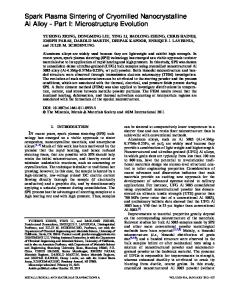Cryomilling and spark plasma sintering of nanocrystalline magnesium-based alloy
- PDF / 640,686 Bytes
- 8 Pages / 584.957 x 782.986 pts Page_size
- 42 Downloads / 355 Views
Christopher Melnyk California Nanotechnologies Inc., Cerritos, California 90703
Wei H. Kao Institute for Technology Advancement, University of California Los Angeles, Los Angeles, California 90095
Jenn-Ming Yang Department of Materials Science and Engineering, University of California Los Angeles, Los Angeles, California 90095 (Received 11 August 2010; accepted 6 December 2010)
The microstructure characteristics of nanocrystalline magnesium-based alloy processed by cryomilling and spark plasma sintering were investigated. The as-received and cryomilled powders and the consolidated bulk material were characterized by scanning and transmission electron microscopies, x-ray diffraction, and electron dispersive spectroscopy techniques. The cryomilled powders resulted in an average grain size of 25 nm. After spark plasma sintering, a bimodal grain size distribution with coarse grains around 500 nm and fine grains of 52 nm, which is one of the smallest grain sizes reported in bulk nanostructured Mg alloys, was found. Our results suggest this novel process as a viable method to provide new opportunities for the development of nanostructured Mg-based alloys.
I. INTRODUCTION
Address all correspondence to this author. e-mail: [email protected]; [email protected] DOI: 10.1557/jmr.2010.94
oxidation reactions during milling are reduced under nitrogen atmosphere. Third, the milling time required to attain a nanostructure is significantly reduced due to the extremely low temperatures during cryomilling, which suppress dynamic recovery and recrystallization.15 The drawback of this processing technique is, however, that small amounts of impurity elements may be introduced during cryomilling and form nanoscale dispersions. However, it is well accepted that the existence of second phases such as oxides, nitrides, and carbides enhances the retarding force on grain-boundary migration, which plays a significant role in stabilizing the microstructure.16 Extensive experiments have been performed to achieve nanostructured Al-based alloys,16–22 Zn–Al alloys,23 Mg–Fe mixtures,24 and Ti alloys25 by cryomilling. However, nanocrystalline Mg-based alloys fabricated by cryomilling have not been reported yet. As of today, grain refinement of Mg and Mg-based alloys to nanometer scale by conventional processing techniques continues to be a challenging task mainly due to the dynamic recovery and recrystallization that cannot be suppressed.26 In addition, it is well known that the hexagonal crystal structure of Mg provides only a limited number of active slip systems. Therefore, factors such as shear planes, grain rotation, and texture seem to play an important role in assisting grain refinement by conventional techniques.27–29 In this work, we demonstrate that nanocrystalline Mg-based alloy
904
Ó Materials Research Society 2011
Nanocrystalline materials have gained a lot of attention as a result of their unique microstructure, which leads to outstanding physical and mechanical properties.1–3 A number of methods have been developed to achieve
Data Loading...











